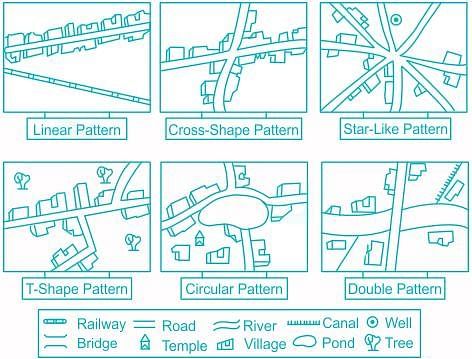CTET & State TET Exam > CTET & State TET Questions > Which rural settlement is known to have a cir...
Start Learning for Free
Which rural settlement is known to have a circular shape?
- a)In this shape the roads are rectangular and cross each other at right angles.
- b)The houses are situated along the road and railway line.
- c)Villages develop on the banks of lakes.
- d)They may be agricultural villages.
Correct answer is option 'C'. Can you explain this answer?
Verified Answer
Which rural settlement is known to have a circular shape?a)In this sha...
- Usually, rural settlements are located near water bodies such as rivers, lakes, and springs where water can be easily obtained. Sometimes the need for water drives people to settle in otherwise disadvantaged sites such as islands surrounded by swamps or low-lying riverbanks.
- Circular pattern: Circular villages develop around lakes, and tanks, and sometimes the village is planned in such a way that the central part remains open and is used for keeping the animals to protect them from wild animals.

Most Upvoted Answer
Which rural settlement is known to have a circular shape?a)In this sha...
Explanation:
Circular Rural Settlements:
- Circular rural settlements are known for their circular shape, with houses arranged in a circular pattern.
- These settlements are often found in areas where the terrain or geographical features influence the layout of the village.
Characteristics of Circular Rural Settlements:
- In circular rural settlements, the roads are often radial, leading out from the center of the village.
- The houses are typically situated along these radial roads, creating a circular pattern of settlement.
- Circular rural settlements may have a central plaza or open space where community activities take place.
Advantages of Circular Rural Settlements:
- The circular layout of the village allows for easy access to the center from all parts of the settlement.
- It promotes a sense of community and social interaction among residents.
- The circular shape also provides a more efficient use of space compared to linear or grid patterns.
Examples of Circular Rural Settlements:
- Circular rural settlements are commonly found in regions with traditional or indigenous communities.
- One famous example of a circular rural settlement is the Circular Congregational Church in Charleston, South Carolina, which is surrounded by a circular graveyard.
Conclusion:
Circular rural settlements are unique in their layout and design, with houses arranged in a circular pattern around a central point. These settlements promote community interaction and efficient land use, making them a distinctive feature of rural landscapes.
Circular Rural Settlements:
- Circular rural settlements are known for their circular shape, with houses arranged in a circular pattern.
- These settlements are often found in areas where the terrain or geographical features influence the layout of the village.
Characteristics of Circular Rural Settlements:
- In circular rural settlements, the roads are often radial, leading out from the center of the village.
- The houses are typically situated along these radial roads, creating a circular pattern of settlement.
- Circular rural settlements may have a central plaza or open space where community activities take place.
Advantages of Circular Rural Settlements:
- The circular layout of the village allows for easy access to the center from all parts of the settlement.
- It promotes a sense of community and social interaction among residents.
- The circular shape also provides a more efficient use of space compared to linear or grid patterns.
Examples of Circular Rural Settlements:
- Circular rural settlements are commonly found in regions with traditional or indigenous communities.
- One famous example of a circular rural settlement is the Circular Congregational Church in Charleston, South Carolina, which is surrounded by a circular graveyard.
Conclusion:
Circular rural settlements are unique in their layout and design, with houses arranged in a circular pattern around a central point. These settlements promote community interaction and efficient land use, making them a distinctive feature of rural landscapes.
Free Test
FREE
| Start Free Test |
Community Answer
Which rural settlement is known to have a circular shape?a)In this sha...
- Usually, rural settlements are located near water bodies such as rivers, lakes, and springs where water can be easily obtained. Sometimes the need for water drives people to settle in otherwise disadvantaged sites such as islands surrounded by swamps or low-lying riverbanks.
- Circular pattern: Circular villages develop around lakes, and tanks, and sometimes the village is planned in such a way that the central part remains open and is used for keeping the animals to protect them from wild animals.


|
Explore Courses for CTET & State TET exam
|

|
Question Description
Which rural settlement is known to have a circular shape?a)In this shape the roads are rectangular and cross each other at right angles.b)The houses are situated along the road and railway line.c)Villages develop on the banks of lakes.d)They may be agricultural villages.Correct answer is option 'C'. Can you explain this answer? for CTET & State TET 2025 is part of CTET & State TET preparation. The Question and answers have been prepared according to the CTET & State TET exam syllabus. Information about Which rural settlement is known to have a circular shape?a)In this shape the roads are rectangular and cross each other at right angles.b)The houses are situated along the road and railway line.c)Villages develop on the banks of lakes.d)They may be agricultural villages.Correct answer is option 'C'. Can you explain this answer? covers all topics & solutions for CTET & State TET 2025 Exam. Find important definitions, questions, meanings, examples, exercises and tests below for Which rural settlement is known to have a circular shape?a)In this shape the roads are rectangular and cross each other at right angles.b)The houses are situated along the road and railway line.c)Villages develop on the banks of lakes.d)They may be agricultural villages.Correct answer is option 'C'. Can you explain this answer?.
Which rural settlement is known to have a circular shape?a)In this shape the roads are rectangular and cross each other at right angles.b)The houses are situated along the road and railway line.c)Villages develop on the banks of lakes.d)They may be agricultural villages.Correct answer is option 'C'. Can you explain this answer? for CTET & State TET 2025 is part of CTET & State TET preparation. The Question and answers have been prepared according to the CTET & State TET exam syllabus. Information about Which rural settlement is known to have a circular shape?a)In this shape the roads are rectangular and cross each other at right angles.b)The houses are situated along the road and railway line.c)Villages develop on the banks of lakes.d)They may be agricultural villages.Correct answer is option 'C'. Can you explain this answer? covers all topics & solutions for CTET & State TET 2025 Exam. Find important definitions, questions, meanings, examples, exercises and tests below for Which rural settlement is known to have a circular shape?a)In this shape the roads are rectangular and cross each other at right angles.b)The houses are situated along the road and railway line.c)Villages develop on the banks of lakes.d)They may be agricultural villages.Correct answer is option 'C'. Can you explain this answer?.
Solutions for Which rural settlement is known to have a circular shape?a)In this shape the roads are rectangular and cross each other at right angles.b)The houses are situated along the road and railway line.c)Villages develop on the banks of lakes.d)They may be agricultural villages.Correct answer is option 'C'. Can you explain this answer? in English & in Hindi are available as part of our courses for CTET & State TET.
Download more important topics, notes, lectures and mock test series for CTET & State TET Exam by signing up for free.
Here you can find the meaning of Which rural settlement is known to have a circular shape?a)In this shape the roads are rectangular and cross each other at right angles.b)The houses are situated along the road and railway line.c)Villages develop on the banks of lakes.d)They may be agricultural villages.Correct answer is option 'C'. Can you explain this answer? defined & explained in the simplest way possible. Besides giving the explanation of
Which rural settlement is known to have a circular shape?a)In this shape the roads are rectangular and cross each other at right angles.b)The houses are situated along the road and railway line.c)Villages develop on the banks of lakes.d)They may be agricultural villages.Correct answer is option 'C'. Can you explain this answer?, a detailed solution for Which rural settlement is known to have a circular shape?a)In this shape the roads are rectangular and cross each other at right angles.b)The houses are situated along the road and railway line.c)Villages develop on the banks of lakes.d)They may be agricultural villages.Correct answer is option 'C'. Can you explain this answer? has been provided alongside types of Which rural settlement is known to have a circular shape?a)In this shape the roads are rectangular and cross each other at right angles.b)The houses are situated along the road and railway line.c)Villages develop on the banks of lakes.d)They may be agricultural villages.Correct answer is option 'C'. Can you explain this answer? theory, EduRev gives you an
ample number of questions to practice Which rural settlement is known to have a circular shape?a)In this shape the roads are rectangular and cross each other at right angles.b)The houses are situated along the road and railway line.c)Villages develop on the banks of lakes.d)They may be agricultural villages.Correct answer is option 'C'. Can you explain this answer? tests, examples and also practice CTET & State TET tests.

|
Explore Courses for CTET & State TET exam
|

|
Signup for Free!
Signup to see your scores go up within 7 days! Learn & Practice with 1000+ FREE Notes, Videos & Tests.























